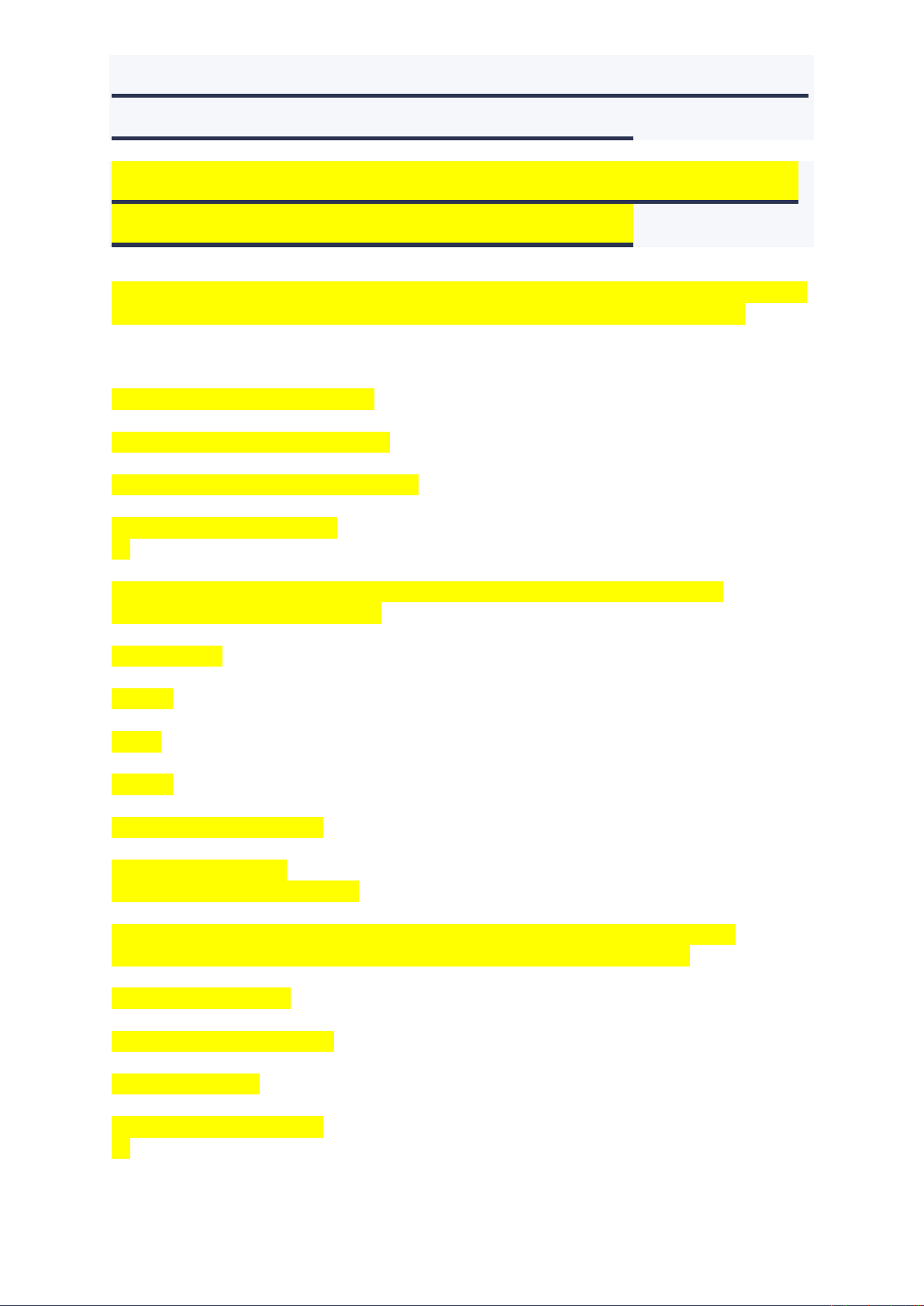
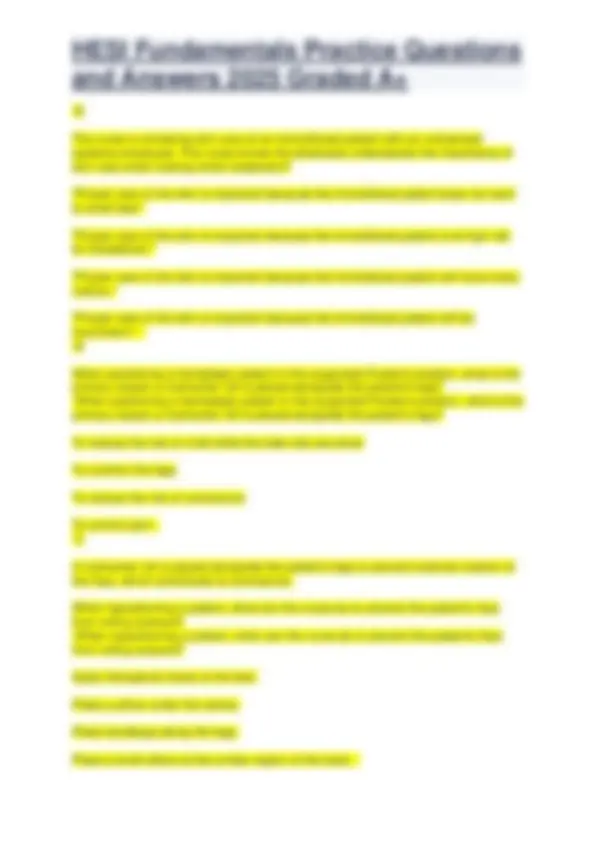
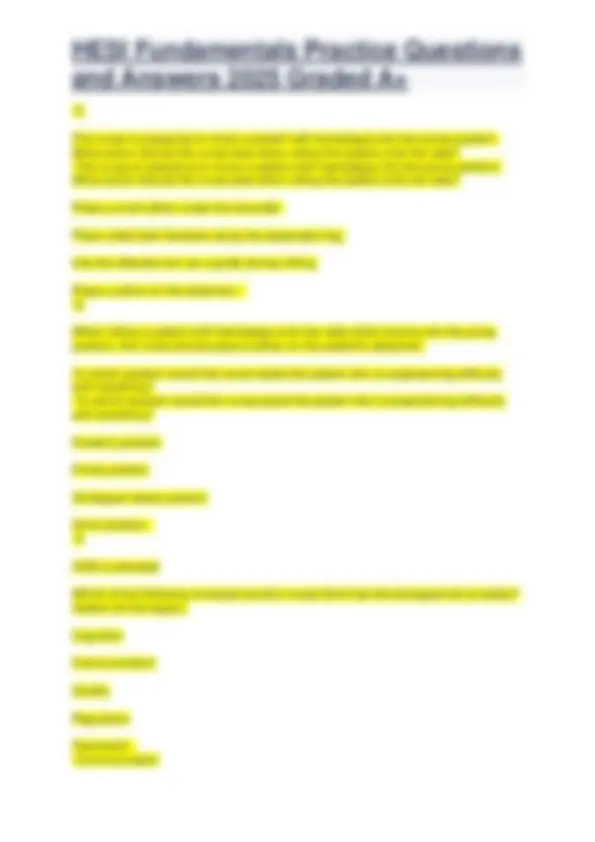
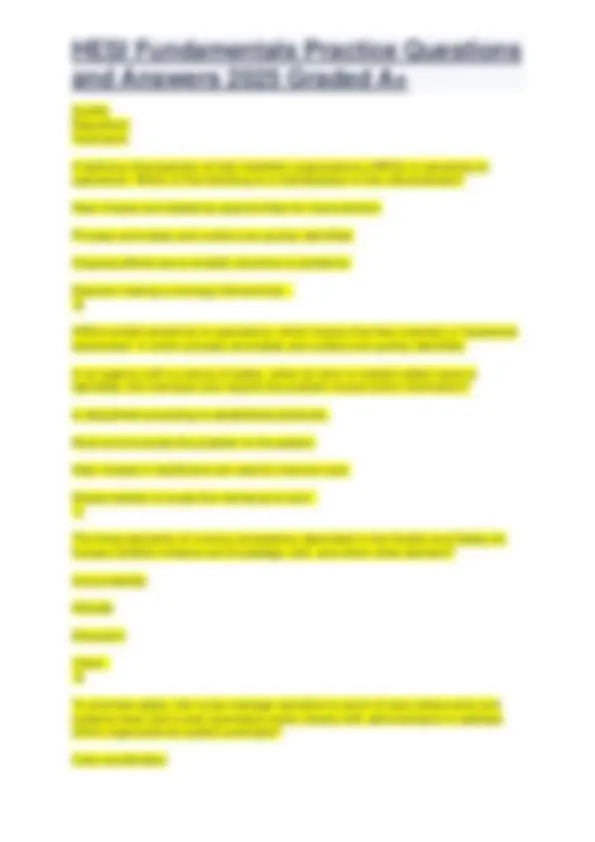
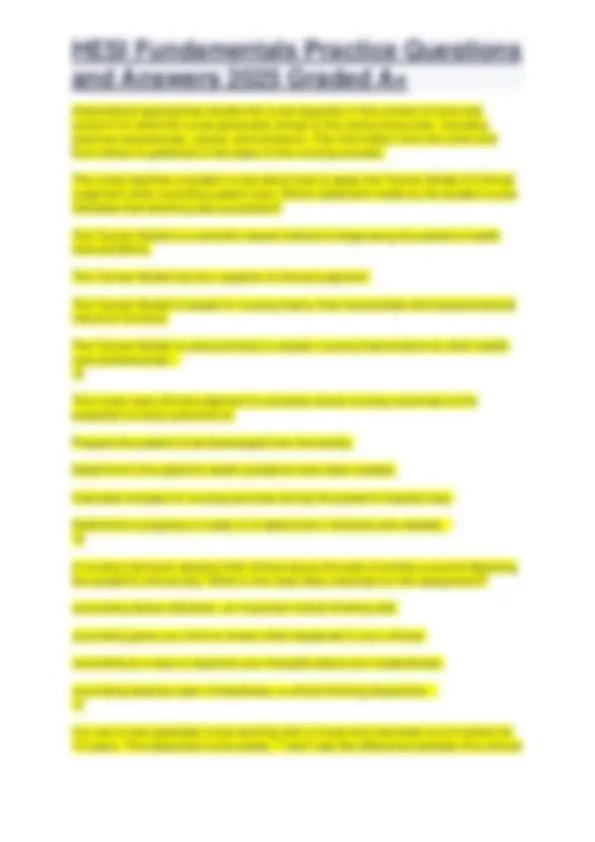
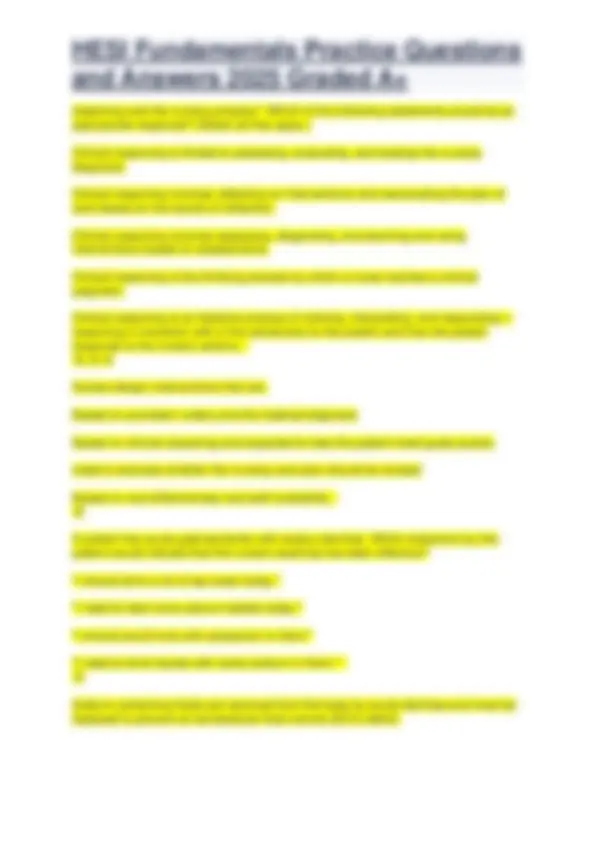
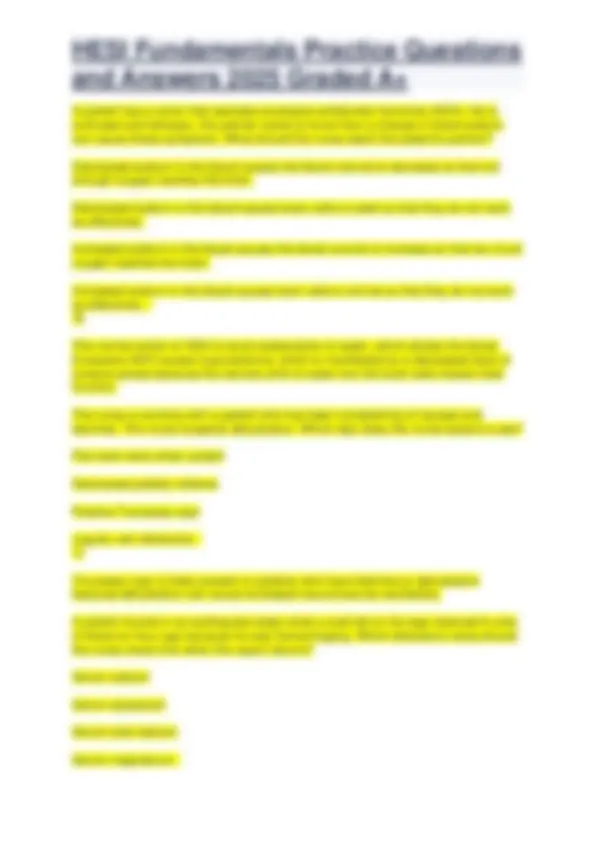


Study with the several resources on Docsity

Earn points by helping other students or get them with a premium plan


Prepare for your exams
Study with the several resources on Docsity

Earn points to download
Earn points by helping other students or get them with a premium plan
Community
Ask the community for help and clear up your study doubts
Discover the best universities in your country according to Docsity users
Free resources
Download our free guides on studying techniques, anxiety management strategies, and thesis advice from Docsity tutors
HESI Fundamentals Practice Questions and Answers 2025 Graded A+.pdf
Typology: Exams
1 / 12

This page cannot be seen from the preview
Don't miss anything!







A child must experience mobility so he or she can explore and learn about the world. Lack of mobility in a child may interfere with which developmental milestone? Physiologic bonding and growth Speech and hearing development Intellectual and psychomotor function Childhood play interaction - C Patients who are experiencing immobility often have which of the following emotions? (Select all that apply.) Helplessness Hunger Anger Anxiety Increased communication Improved self-worth - Helplessness, Anger, Anxiety The nurse is caring for a patient who has a suspected fracture. Which of the following assessments is most important for the nurse to perform first? Elevate the extremity. Splint the suspected injury. Check the pulses. Verify all immunizations. - C
The nurse is caring for a patient who will be discharged following a fracture to the forearm. Which of the following should the nurse include in the discharge instructions? Keep the left shoulder elevated on a pillow or cushion. Keep the hand immobile to prevent soft tissue swelling. Call the health care provider if numbness of the hand occurs. Avoid nonsteroidal antiinflammatory drugs (NSAIDs) for 24 hours after the injury. - C The nurse is caring for a patient who sustained a hip fracture and had an open reduction and internal fixation (ORIF) of a hip fracture. The patient will be getting out of bed for the first time postoperatively. Which should the nurse do next? Use a mechanical lift to transfer the patient from the bed to the chair. Check the postoperative orders for the patient's weight-bearing status. Avoid administration of pain medications before getting the patient up. Delegate the transfer of the patient to nursing assistive personnel (NAP). - B A nurse observes a patient walking in the hall. Which assessment is the nurse able to complete? Gait and balance Speech and hearing Mental alertness Ability to follow directions - A During infancy, childhood, and adolescence, which nutrients are critical for the musculoskeletal development? Vitamins and minerals Protein and calcium Fats and carbohydrates Zinc and potassium -
The nurse is preparing to move a patient with hemiplegia into the prone position. What action should the nurse take when rolling the patient onto her side? The nurse is preparing to move a patient with hemiplegia into the prone position. What action should the nurse take when rolling the patient onto her side? Place a small pillow under the shoulder. Place rolled bath blankets along the dependent leg. Use the affected arm as a guide during rolling. Place a pillow on the abdomen. - D When rolling a patient with hemiplegia onto her side while moving into the prone position, the nurse should place a pillow on the patient's abdomen. To which position would the nurse assist the patient who is experiencing difficulty with breathing? To which position would the nurse assist the patient who is experiencing difficulty with breathing? Fowler's position Prone position 30 - degree lateral position Sims' position - A HOB is elevated Which of the following concepts would a nurse think has the strongest link to safety? (Select all that apply.) Cognition Communication Quality Regulation Teamwork - Communication
Quality Regulation Teamwork A defining characteristic of high reliability organizations (HROs) is sensitivity to operations. Which of the following is a manifestation of this characteristic? Near misses are treated as opportunities for improvement. Process anomalies and outliers are quickly identified. Ongoing efforts are to simplify solutions to problems. Decision making is strongly hierarchical. - B HROs exhibit sensitivity to operations, which means that they maintain a "situational awareness" in which process anomalies and outliers are quickly identified. In an agency with a culture of safety, when an error or patient safety issue is identified, the individual who reports the problem knows which information? Is disciplined according to established protocols. Must communicate the problem to the patient. Near misses in healthcare are used to improve care. Shares details to locate the individual at fault - C The three elements of nursing competency described in the Quality and Safety for Nurses (QSEN) initiative are knowledge, skill, and which other element? Accountability Attitude Education Value - B To promote safety, the nurse manager sensitive to point-of-care (sharp-end) and systems-level (blunt-end) exemplars works closely with administrators to address which organizational system exemplar? Care coordination
Which statement is included in the clinical reasoning communication category? The mathematical calculation process by which a nurse verifies a medication dosage. Relying heavily on analytic reasoning that requires systematically breaking a situation down into parts, examining alternatives, and weighing options. Using experiential knowledge, the nurse begins to put everything together to make sense of it. Clinical judgment is inherently complex and influenced by many factors related to the particular patient and caregiving situation. - B A nurse wishes to obtain data about a new patient's self-esteem. To gain the clearest picture, the nurse uses which assessment technique? Completing an entire head-to-toe assessment first Conducting a structured interview with direct questions Interviewing the patient in an unstructured format Disregard any nonverbal clues from the patient - C An interpretivist nurse is caring for a patient in the hospital setting. Which of the following factors will the interpretivist consider when caring for this patient? (Select all that apply.) Context of care The information from the chart What the nurse personally brings to the caring encounter Information from significant others and friends The nurse's previous experiences, values, and emotions - A, D, E
Interpretivist approaches situate the nurse squarely in the context of care and account for what the nurse personally brings to the caring encounter, including previous experiences, values, and emotions. The information from the chart and from others is gathered in the steps of the nursing process. The nurse teaches a student nurse about how to apply the Tanner Model of Clinical Judgment when providing patient care. Which statement made by the student nurse indicates that teaching was successful? The Tanner Model is a scientific-based method of diagnosing the patient's health care problems. The Tanner Model has four aspects of clinical judgment. The Tanner Model is based on nursing theory that incorporates the biopsychosocial nature of humans. The Tanner Model is used primarily to explain nursing interventions to other health care professionals. - B The nurse uses clinical judgment to compare actual nursing outcomes to the expected nursing outcomes to: Prepare the patient to be discharged from the facility. Determine if the patient's health problems have been treated. Calculate charges for nursing services during the patient's hospital stay. Determine if progress is made or to determine if revisions are needed. - D A nursing instructor assigns their clinical group the task of writing a journal depicting the student's clinical day. What is the most likely rationale for this assignment? Journaling allows reflection, an important critical thinking skill. Journaling gives you time to review what happened in your clinical. Journaling is a way to organize your thoughts about your experiences. Journaling teaches open-mindedness, a critical thinking disposition. - A You are a new graduate nurse working with a nurse who has been out of school for 10 years. The seasoned nurse states, "I don't see the difference between this clinical
A patient has a tumor that secretes excessive antidiuretic hormone (ADH). He is confused and lethargic. His partner wants to know how a change in blood sodium can cause these symptoms. What should the nurse teach the patient's partner? Decreased sodium in the blood causes the blood volume to decrease so that not enough oxygen reaches the brain. Decreased sodium in the blood causes brain cells to swell so that they do not work as effectively. Increased sodium in the blood causes the blood volume to increase so that too much oxygen reaches the brain. Increased sodium in the blood causes brain cells to shrivel so that they do not work as effectively. - B The normal action of ADH is renal reabsorption of water, which dilutes the blood. Excessive ADH causes hyponatremia, which is manifested by a decreased level of consciousness because the osmotic shift of water into the brain cells impairs their function. The nurse is working with a patient who has been complaining of nausea and diarrhea. The nurse suspects dehydration. Which sign does the nurse expect to see? Flat neck veins when upright Decreased patellar reflexes Positive Trousseau sign Jugular vein distension - C Trousseau sign is likely present in patients who have diarrhea or dehydration because dehydration can cause increased neuromuscular excitability. A patient injured in an earthquake today when a wall fell on his legs received 9 units of blood an hour ago because he was hemorrhaging. Which laboratory value should the nurse check first when the report returns? Serum sodium Serum potassium Serum total calcium Serum magnesium -
The patient has two major risk factors for hyperkalemia: massive sudden cell death from a crushing injury (potassium shift from cells into the extracellular fluid) and massive blood transfusion (rapid potassium intake). A patient has newly diagnosed hyperparathyroidism. What should the nurse expect to find during an assessment at the beginning of the nursing shift? Lethargy and constipation from hypercalcemia Positive Trousseau's sign from hypercalcemia Lethargy and constipation from hypocalcemia Positive Trousseau's sign from hypocalcemia - A Parathyroid hormone (PTH) shifts calcium from the bones into the extracellular fluid (ECF). Excessive PTH causes hypercalcemia, which is manifested by lethargy and constipation. The home health nurse should assess a patient who has chronic diarrhea for which fluid and electrolyte imbalances? Extracellular fluid volume (ECV) excess Extracellular fluid volume (ECV) deficit Hypokalemia Hyperkalemia Hypocalcemia Hypercalcemia - B, C, E Chronic diarrhea has a high risk of causing ECV deficit, hypokalemia, and hypocalcemia because it increases the fecal output of sodium-containing fluid, potassium, and calcium. The nurse suspects that a patient has a decreased cellular volume with a possible electrolyte imbalance. The provider has ordered blood chemistry laboratory tests. What is the most important nursing intervention for this patient until laboratory results confirm this suspicion?